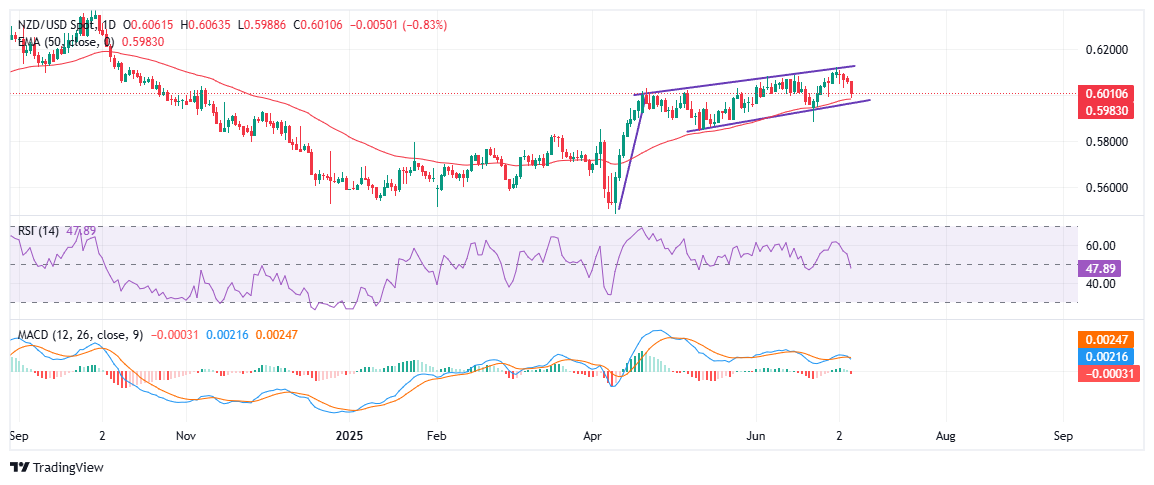- The NZD/USD extends its decline for the third consecutive day, pressed by risk aversion and a cautious environment before the RBNZ interest rate decision.
- The markets expect that the RBNZ maintain the OCR at 3.25% on Wednesday, after six consecutive rate cuts.
- The 50 -day EMA about 0.5980 acts as a key support, reinforcing the lower limit of the bullish flag pattern.
The New Zealand dollar (NZD) extends its loss streak against the US dollar (USD) for the third consecutive day on Monday, with the NZD/USD quoting about 0.6005, lowering almost 0.90% in the day. The Kiwi is under pressure while the operators adopt a cautious posture before the New Zealand Reserve Bank (RBNZ) Reserve Bank on Wednesday, while the feeling of risk aversion, driven by US tariff threats, adds down pressure.
The New Zealand Reserve Bank (RBNZ) is ready to announce its last policy decision on Wednesday. The markets expect that the Central Bank maintains the official cash (OCR) rate (OCR) in 3.25%, after six consecutive cuts since August 2024. According to a Reuters survey carried out from June 30 to July 3, 19 of 27 economists expect the RBNZ to maintain the OCR in 3.25%, while eight see a possible cut of 25 bp. Even so, investors anticipate one or two additional cuts of 25 basic points later this year due to downward risks for growth due to the economic impact of US tariffs.
The Central Bank faces a delicate equilibrium act, since inflation has retreated within its target range of 1–3% and the economy shows cooling signs. However, the Kiwi remains vulnerable to winds against global, including the growing commercial tensions between the US and China and the deceleration of demand in China. Analysts will closely examine the tone of the RBNZ statement in search of clues on the future path of interest rates.

Technically, despite the recent setback, the widest structure of the NZD/USD graph remains constructive, with the torque consolidating within a well -defined bullish flag pattern. This pattern, typically seen as a pause within a bullish trend, suggests that the Kiwi could be preparing for another leg on the rise, provided that the key support levels are maintained. The price action in the daily graph shows that the NZD/USD is maintained above the lower limit of the flag, which also coincides with the 50 -day EMA in 0.5983, a level that has acted as dynamic support throughout May and June. A rebound from this area could confirm the pattern and pave the way for a break above the 0.6100 mark.
However, impulse indicators are beginning to reflect a more cautious tone. The relative force index (RSI) has fallen to 48.2, moving below the 50’s neutral threshold, indicating a fading of the bullish impulse without even indicating overall conditions. Meanwhile, the convergence/divergence of mobile socks (MACD) has become less encouraging. The MACD line has crossed below the signal line, and the histogram has entered negative territory, indicating a bassist crossing. Although this crossing is still relatively superficial, it highlights a loss of bullish impulse and increases the risk of a break down if the price action is further weaken.
In the short term, 0.5980 remains the key support zone, a confluence of the lower limit of the flag and the 50 -day EMA. A decisive daily closure below this area would invalidate the bullish flag and change the short -term inclination in favor of bassists, exposing the next support levels around 0.5900.
Economic indicator
RBNZ interest rates
He New Zealand Reserve Bank (RBNZ) announces its decision on the interest rate after each of its seven annual policy meetings. If the RBNZ adopts a hard line posture and observes that inflationary pressures are increasing, the official cash (OCR) rate increases to reduce inflation. This is positive for the New Zealand dollar (NZD), since higher interest rates attract more capital tickets. Similarly, if it concludes that inflation is too low, it reduces OCR, which tends to weaken the NZD.
Read more.
Next publication:
LIÉ JUL 09, 2025 02:00
Frequency:
Irregular
Dear:
3.25%
Previous:
3.25%
Fountain:
Reserve Bank of New Zealand
The New Zealand Bank Reserve (RBNZ) celebrates monetary policy meetings seven times a year, announcing its decision on interest rates and economic evaluations that influenced their decision. The Central Bank offers clues about economic perspectives and the future path of politics, which are of high relevance for the assessment of the NZD. Positive economic developments and an optimistic perspective could lead the RBNZ to harden policy by increasing interest rates, which tends to be bullish for the NZD. Policy ads are usually followed by the press conference of interim governor Christian Hawkesby.
Source: Fx Street
I am Joshua Winder, a senior-level journalist and editor at World Stock Market. I specialize in covering news related to the stock market and economic trends. With more than 8 years of experience in this field, I have become an expert in financial reporting.







